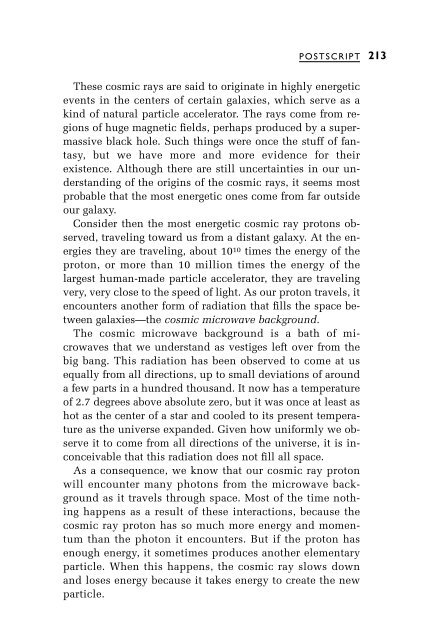Three Roads To Quantum Gravity
Three Roads To Quantum Gravity
Three Roads To Quantum Gravity
You also want an ePaper? Increase the reach of your titles
YUMPU automatically turns print PDFs into web optimized ePapers that Google loves.
POSTSCRIPT 213<br />
These cosmic rays are said to originate in highly energetic<br />
events in the centers of certain galaxies, which serve as a<br />
kind of natural particle accelerator. The rays come from regions<br />
of huge magnetic fields, perhaps produced by a supermassive<br />
black hole. Such things were once the stuff of fantasy,<br />
but we have more and more evidence for their<br />
existence. Although there are still uncertainties in our understanding<br />
of the origins of the cosmic rays, it seems most<br />
probable that the most energetic ones come from far outside<br />
our galaxy.<br />
Consider then the most energetic cosmic ray protons observed,<br />
traveling toward us from a distant galaxy. At the energies<br />
they are traveling, about 10 10 times the energy of the<br />
proton, or more than 10 million times the energy of the<br />
largest human-made particle accelerator, they are traveling<br />
very, very close to the speed of light. As our proton travels, it<br />
encounters another form of radiation that fills the space between<br />
galaxies—the cosmic microwave background.<br />
The cosmic microwave background is a bath of microwaves<br />
that we understand as vestiges left over from the<br />
big bang. This radiation has been observed to come at us<br />
equally from all directions, up to small deviations of around<br />
a few parts in a hundred thousand. It now has a temperature<br />
of 2.7 degrees above absolute zero, but it was once at least as<br />
hot as the center of a star and cooled to its present temperature<br />
as the universe expanded. Given how uniformly we observe<br />
it to come from all directions of the universe, it is inconceivable<br />
that this radiation does not fill all space.<br />
As a consequence, we know that our cosmic ray proton<br />
will encounter many photons from the microwave background<br />
as it travels through space. Most of the time nothing<br />
happens as a result of these interactions, because the<br />
cosmic ray proton has so much more energy and momentum<br />
than the photon it encounters. But if the proton has<br />
enough energy, it sometimes produces another elementary<br />
particle. When this happens, the cosmic ray slows down<br />
and loses energy because it takes energy to create the new<br />
particle.



![arXiv:1001.0993v1 [hep-ph] 6 Jan 2010](https://img.yumpu.com/51282177/1/190x245/arxiv10010993v1-hep-ph-6-jan-2010.jpg?quality=85)


![arXiv:1008.3907v2 [astro-ph.CO] 1 Nov 2011](https://img.yumpu.com/48909562/1/190x245/arxiv10083907v2-astro-phco-1-nov-2011.jpg?quality=85)








![arXiv:1002.4928v1 [gr-qc] 26 Feb 2010](https://img.yumpu.com/41209516/1/190x245/arxiv10024928v1-gr-qc-26-feb-2010.jpg?quality=85)
![arXiv:1206.2653v1 [astro-ph.CO] 12 Jun 2012](https://img.yumpu.com/39510078/1/190x245/arxiv12062653v1-astro-phco-12-jun-2012.jpg?quality=85)
